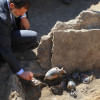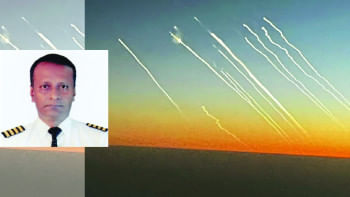Exciting scientific discoveries

It is not very often that we hear about groundbreaking scientific advances in Bangladesh. So, reports in The Daily Star on two successive mornings about two exciting discoveries were very special. On September 6, The Daily Star reported an announcement, made at a press conference the day before, that a research team at Sylhet University of Science and Technology (SUST) had developed a novel optical technique for rapid and inexpensive detection of cancer. On September 7, the newspaper published an excellent article by Pinaki Roy and Muntakim Saad on the sequencing of the Hilsa fish genome by researchers at Dhaka University (DU) and NRB scientists. These significant achievements demonstrate what our scientists are capable of if given only half a chance.
The research at SUST deserves special mention as it is a totally home-grown initiative, with the latest stage funded through the Higher Education Quality Enhancement Project (HEQEP) of UGC. Dr Yasmeen Haque, and her colleagues and students at SUST, have not only pioneered the field of laser physics and non-linear optics in Bangladesh, but have also developed novel technologies and built required equipment themselves, including a simple device that uses non-linear optics for diagnosis of cancer. A provisional patent has been filed based on the observation that interaction of laser light with some "biomarker" in the blood/serum of cancer patients produces very specific non-linear optical characteristics that are not seen in the blood/serum of healthy individuals. Is the company that supplied the blood samples listed as a co-inventor, and is it a Bangladeshi company?
The published reports do not specify if the experimental samples represented a wide variety of cancers or only one type. If the diagnostic test can reproducibly detect all types of cancer then the SUST researchers could have stumbled upon a singular cancer "biomarker" that thousands of researchers have been looking for over the last five decades through differential expression of genes and gene products including tens of thousands of structural and functional proteins. The SUST team could expand the search for the elusive but ubiquitous optical biomarker to include previously uncharacterised extracellular vesicles and exosomes that could be released from early stage cancerous and precancerous cells.
The research team at SUST has built up a commendable critical mass of 21 physicists. They would be well served by building a multidisciplinary team with complementary expertise in cancer biology and medicine. The validation of their finding will require extensive multidisciplinary research, supervised access to large cohorts of cancer patients at different stages of disease progression, and compliance with national and international regulatory requirements. Any research involving humans or human specimens requires prior approval from an institutional Human Research Bioethics Committee, and the inclusion of qualified experts such as a clinical oncologist in this case. These requirements also need to be met for obtaining regulatory approval (from FDA in USA, DGDA in Bangladesh) for the commercialisation of any new medical or diagnostic device that uses human specimens.
The identification and characterisation of the previously unknown cancer-derived "optical biomarker" could generate new Intellectual Property (IP) of immeasurable medical and commercial value. Studies leading to the unequivocal identification and full physicochemical and biological characterisation of the cancer-derived "optical biomarker"may take longer than the 18 months available before the provisional patent is published. If warranted, they may wish to consider filing a series of rolling provisional patent applications which can be consolidated into one international patent. The maintenance (for up to 20 years) of patents, granted at the national phase, can cost upwards of USD 20,000 per country/region every year which is simply beyond the means of any academic or research organisation in Bangladesh. If commercialisation is warranted, then all patent costs should preferably be borne by a Bangladeshi commercial partner to ensure that the IP is locally-owned and royalties are shared within Bangladesh.
On September 7, The Daily Star reported the sequencing of Hilsa fish genome by a multidisciplinary research team coordinated by Dhaka University Professor Haseena Khan, who incidentally also played a leading role in the sequencing of the jute genome a few years back. NRB scientists played a crucial role in these projects. Hilsa fish samples were collected from different habitats by Professor Niamul Naser of DU's Zoology Department, and researchers at DU's Biochemistry and Molecular Biology Department including Professor Riazul Islam and a host of young researchers prepared the samples for sequencing. The sequencing was carried out by a US-based DU alumnus, Dr Mong Sano Marma, using facilities generously made available by his friend Dr Peter Inakiev. Bioinformatics support was provided by Australia-based DUBMB alumnus, Dr Abdul Baten.
The jute and Hilsa sequencing projects are wonderful examples of what multidisciplinary and multi-institutional research can accomplish and how NRB scientists can provide invaluable support to overcome a serious dearth of expertise and facilities that adversely affects internationally competitive research in Bangladesh. But instead of banking on informal and sporadic contacts, the rich pool of NRB scientists and experts should be formally invited by the government to help develop research capacity, provide access to contemporary technologies in their laboratories, and mentor young researchers from Bangladesh.
The cost of sequencing has come down drastically since the days of the jute genome sequencing. A full genome can now be sequenced and decoded for around USD 2,000 by overseas companies, but the IP could be compromised. The technologies and equipment needed for genomics, functional genomics, bioinformatics, and other molecular bioscience technologies dependent on powerful computation, are so commonplace now that our researchers should have ready access to them in Bangladesh. Also, instead of relying on foreign experts, Bangladeshi researchers should be able to seek expert advice on matters related to IP and commercialisation from a National Technology Transfer Office.
Young researchers and students have played pivotal roles in both the recent scientific discoveries. In advanced countries research students and postdoctoral researchers have always driven the research engine for socioeconomic development. Young researchers should also be at the forefront of research and innovation in Bangladesh and help redress the unfortunate situation that Bangladesh is the least innovative country in Asia (The Daily Star, September 18). The recent success stories will undoubtedly create interest in research careers among the young in Bangladesh, but how can their enthusiasm be sustained and how do we stop them from moving abroad?
The strongest antidote to stem brain drain, and reverse it, is to create a conducive and enabling research atmosphere that allows our best brains to carry out world-class research in Bangladesh on projects of national importance. This is possible through Article 11 of the Higher Education Commission (HEC) draft law if the policymakers decide to consider the recommendations made here, and in a recent op-ed (The Daily Star, September 9). This may not be straight forward. Even if the proposed HEC were inclined to strengthen postgraduate research and innovation to improve international competitiveness, its ability to work freely and implement the necessary changes would be greatly curtailed by the highly bureaucratic administrative structure proposed in the HEC draft law. This unnecessary problem, should it arise, needs to be speedily resolved in the national interest.
Ahmed Abdullah Azad is a retired academic and scientist who has been championing biotechnology research capacity development in Bangladesh for a long time. He is the Secretary General of the Islamic-World Academy of Sciences (IAS). Email: [email protected]






Comments